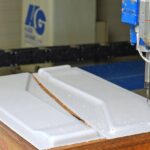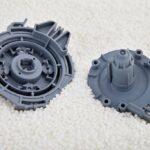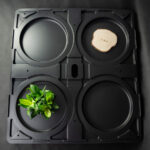Sometimes what on the surface appears to be a cost-saving measure, in reality ends up... double the cost. This, unfortunately, was the case with the slope protection of retention tanks, where the decision to "optimize" materials and accessories led to serious structural problems. Thanks to the commitment of our team and verification of technical parameters, the safety and stability of the structure was restored. Our text is a warning to those who optimize at all costs.

Find out what you should never save on and how one decision can affect the stability of the entire structure.
What was the subject of the investment?
The investment task included the construction of retention basins sealed with HDPE geomembrane, which acted as a separation and sealing layer. Slopes with a slope of 1:1 to 1:1.5 had to be protected with a 60 cm thick sand ballast layer. A cellular geo-grid filled with humus was laid on such a prepared surface. Its task was to stabilize the slopes and protect them from erosion.
What problem did the customer face?
At first glance, the construction appeared solid - the layers had been laid as designed, and the tanks were ready for operation. Unfortunately, after the first heavy rainfall, the cellular geo-grid detached from the slope, leading to damage and slipping of the material. The structure? It could not withstand the pressure of water and shifting humus.
However... what exactly went wrong? At this point, the Geo Globe Poland team joined the analysis of the situation. It quickly became clear that the cause of the problem was an attempt at excessive "optimization" of costs. Materials and accessories were used that were adapted neither to the characteristics of the tanks nor to the field conditions.
Key technical problems of the analyzed investment
Our analysis revealed that the main source of the problem was the contractor's excessive attempt to "optimize" costs. Materials and accessories were used that were not adapted to the field conditions or the characteristics of the project:
- An oversized geo-grid cell (GKL-712) was used
The first and key mistake was to use too large a cell geonets (GKL-712) on slopes with a slope of 1:1. In these types of conditions, the manufacturer explicitly recommends the use of smaller modules (GKS-330 or GKS-356), which can better cope with surface loads. The difference between these solutions is significant. The 330 mm cell forms as many as 40 meshes per square meter, while the 712 mm version has only 9. With identical weld strength, the denser structure translates into greater stability and durability of the entire structure.
- Ribbed steel anchors with a diameter of only 6 mm were used
The second major error was inadequate anchoring of the geogrid. Ribbed steel anchors with a diameter of only 6 mm were used, and they were spaced too far apart. Meanwhile, the recommended anchoring scheme provides for anchoring every fourth cell vertically, every second cell horizontally, and in each cell on the crown of the slope. In addition, to ensure adequate stability of the structure, the diameter of the anchors should be at least 10 mm
- No PP or PES tension lines used
The third mistake was the complete omission of tensioning cables made of PP or PES plastic. These accessories perform an important function - they stabilize the structure, add weight to it and prevent the movement of humus under the geonet during backfilling. Their absence significantly weakened the durability of the system and increased the risk of local overloading.
All of these errors directly resulted in the loss of stability of the entire structure. The lack of proper anchoring and tensioning cables caused humus to penetrate under the geonet, pushing it out and weakening its adhesion to the slope. At the points of greatest stress, overloading occurred, which ultimately resulted in mechanical damage and the detachment of material fragments. This is a model example of a situation in which apparent economy leads to serious consequences. Both technical and financial ones.
Solution designed by Geo Globe Poland
After analyzing the situation, we proposed redesigning the slope geometry and reassembling the system using proper anchoring and appropriate accessories to support the structure. The client wanted to use the same type of cellular geogrid. Our calculations confirmed that it would be possible to safely use the previously selected material when the slope angle changes.
In order to adapt the system to field conditions and customer expectations, we have introduced the following solutions:
- Changing the slope of slopes: from 1:1 to 1:2.5.
- Material used: GKL-71220060TPC cellular geogrid.
- Anchoring:
- Ribbed steel fi 10 mm.
- Scheme: every 4th cell vertically, every 2nd cell horizontally, and every cell on the crown of the slope.
- Anchors J60 (on the slope surface) and J100 (on the crown).
- Structural stress relief:
- Tension cables made of polypropylene (PP) with a diameter of 8 mm.
- 3 links for each section.
The end result - what did the customer gain?
The implemented changes allowed us to effectively protect the slopes and create a durable, functional structure. Our client gained:
✅ Stable and safe construction
The system performs its function even in harsh weather conditions, and the slopes remain intact.
✅ Proper selection of technology
The solution has been adapted to realistic soil and water conditions and technical requirements.
✅ A valuable lesson for the future
Although it's not the point you count on in the investment schedule, we are confident that the experience gained from this implementation will bear fruit in the future. The project has shown that excessive "optimization" can be costly.
Check: https://www.geoglobe.pl/geokrata-na-skarpy-o-wysokosci-5-cm-10-cm-czy-15-cm-jaka-wybrac/
Do you have a design challenge? Contact our team - we will advise and propose a solution tailored to the conditions of your project.
Follow us on social media
You may also be interested in:
- Understanding CNC machines: What should you know about their operation and benefits?Is it possible to produce quickly, precisely and without any worries about repeatability? CNC machines make what used to require the hand of a master and many hours of adjusting, happen today in an automated, controlled and predictable way. After all, CNC machines work on projects where accuracy to tenths of a millimeter counts, as well as full control over every stage of machining. But how does this technology actually work, and why should it be used in the production of plastic components?
- The use of plastics in industryDo you know what the bottle of the iconic Family Shampoo has in common with the engine cover on a Tesla Model 3? Well, more than you might expect. Plastics today play a key role in modern industrial processes - from everyday objects to high-tech components used in automotive, aerospace and construction. Their versatility and innovation are second to none. ...
- Plastic Moldings and Thermoformed Extrusions: Advantages and Applicability in Various IndustriesIt's hard to find an industry today that doesn't need a precision-engineered, lightweight yet durable plastic component. From delicate blisters in pharmaceuticals, to transport trays on automotive lines, to ESD anti-static extrusions to protect electronics during manufacturing and logistics, thermoformed extrusions are popping up everywhere.
- Vice President Dobrochna Kochanska an official member of the Business Center ClubVice President Dobrochna Kochanska an official member of the Business Center Club

















